I came to the realization that I had too many images, more than I would ever realistically edit. It was time to really dig into my image collections and do a little image culling. I fired up Adobe Bridge, as it was a quick way to view folder contents and I did not want to load images into Lightroom until I had everything ready.
I opened my very first upload of images from my first DSLR. Right off the bat I noticed that they were still in CR2 format. It must have been a while since I last glanced at these images, as I have been using DNG as my sole raw format for the past year and a half. Decided I needed to convert these images, but I wanted to see what I had before I did.
So I opened the folder in Bridge. Then my eyes cringed at the horror of poorly focused and badly composed images. Clearly this was the work of someone who had just got their first DSLR and was getting back into photography. So I glanced through the 300 plus images in that folder and realized that I had no need to be keeping hardly any of these images.
Using Bridge, I quickly went through and removed any images that I felt were not good quality or had any redeeming value otherwise. Then I move onto the next folder. After 400 plus folders of deletions, including a few completed folders deleted, I checked to see what the results were. I took my image collection from 1.2 terabytes and culled it down to a mere 300 gigabytes. In all over 800 gigabytes of bad, duplicate or unneeded images gone. They were out of my Lightroom catalogs, off of my hard disk and off my online backup.
Be vicious when critiquing. Image culling is important. The harder you are on your images, the more you will find yourself improving.
So now I have a lightened catalog, composed of only images I feel are worthy of remaining for one reason or another. I culled the images using a simple set of criteria, and if you find yourself deluged with an excess of images, these criterion can assist you in separating the wheat from the chaff in your image collections.
- Is this image technically good? Good focus and depth of field, good composition?
- Is this image part of a series of duplicate images? If you shoot a series of shots or bracket your exposures, you may want to remove redundant images.
- If image is not perfect, does it show some possible value? Could a part be used for composite images, or can it be cropped down to make it a better image? Is it a bad shot of something you can shoot again? If so keep it for reference.
- Does the image depict an event or person of importance? Even a poor image can be good to keep if it was a once in a lifetime opportunity.
- Does the image have sentimental value to you? If you have a personal attachment to the content and you cannot reproduce the image, you may want too keep it.
Consider these criteria for every image, if you answer each point honestly you will find that you will be deleting a good portion of your images. What photos remain are your keepers, but just because you are keeping them does not mean they deserve a home in your Lightroom catalog.
You can remove the raw file from you catalog and keep it on your disk. Another option is to convert the raw image to a jpeg for keeping and delete the raw file.
Removing your bad images helps you to be a better photographer. As you shoot and cull more, you will find your standards grow, your images improve and you become a better photographer. Plus you save disk space and remove wasteful images that consumer you time and clutter your catalog.
I used Bridge to carry out my selections and removal, but normally we would be in Lightroom. If you have a massive collection you are planning on culling, bridge may be the better option, but if you are culling a single session or memory card, Lightroom is a better tool for the job.
Let’s take a quick look at the process used to remove images from your disk directly from Lightroom. First, start your import; you can convert to DNG now as well if you choose to. Go ahead and get 1:1 previews generated, as you want to see the full quality image when judging images for removal.
Once everything is loaded, you can start critiquing your images. At this time you can either quickly mark images for deletion, or rate all the images in the upload. I recommend you to give the entire upload initial ratings, since you are taking time to review images you may as well review them all.
Since we are going to rate the entire upload, we need a strategy to determine which images we wish to eliminate. We could simply use selection flags, but I find it better to go ahead and use the star system, as even the keepers will be initially rated for quality leading to a more efficient workflow later. Remember your shortcut keys here, as you do not want to waste time clicking on stars. This is an easy shortcut to remember, simply 1, 2, 3, 4, 5, and 0. You can use either the number row on your keyboard or the 10-key, and the number you select is the number of stars applied.
Now simply work through your images in the Library Module. I usually enlarge the thumbnails to full screen, to allow for better inspection and to limit distraction. Each image should be inspected on its own, with no other distraction, that way you are sure to honesty rate the image. Then start rating the images.
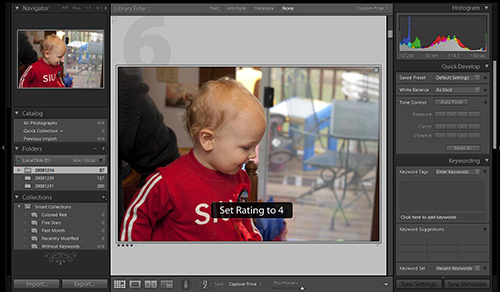
When using a star system, I feel it is best to rate any keepers and leave the throw away images unrated. Obviously, give your best images 5 stars. Any good keepers should get 4 stars.
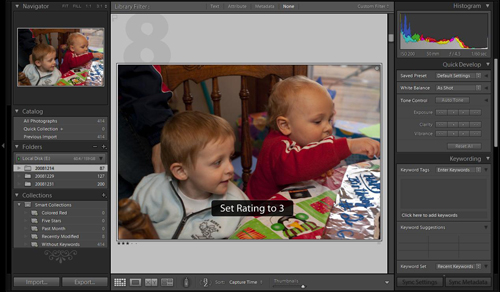
As you work through the images being kept for subject importance, possible value and sentimental reasons rate them between 1 and 3 stars. Give the better images higher ratings and the ones you are keeping, but may get rid of later 1 star.
Once you complete your survey of images, you can then use smart collections to view your images as categorized by ratings. In the Collections Palette on the left menu bar in the Library Module, click on the (+) icon.
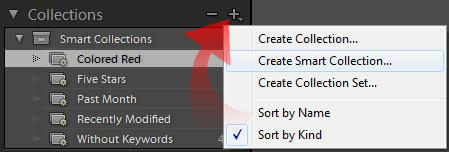
Select Create Smart Collection…
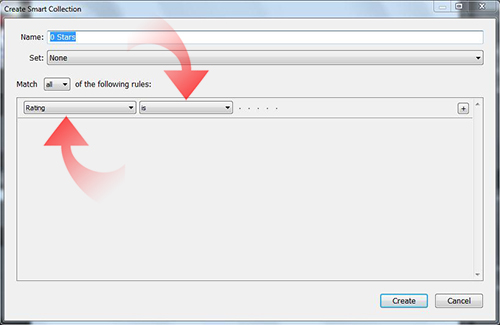
Configure a smart collection for images with zero stars. Make sure to set the first box to Rating, the second box to is and finally select how many stars you want to filter for. Leave 5 dots if you want 0 stars. Click Create.
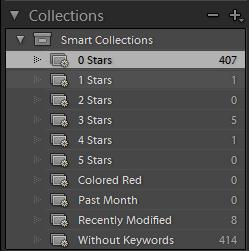
This places your new Smart Collection into the Collections Palette. The Smart Collection configured above will pull all your throw-away images into a collection. Give them all a good once over to make sure you did not erroneously rate any images. Once you are sure that all these images are deletion worthy, select all {Ctrl/Cmd + A} and flag the images as reject using the X key.
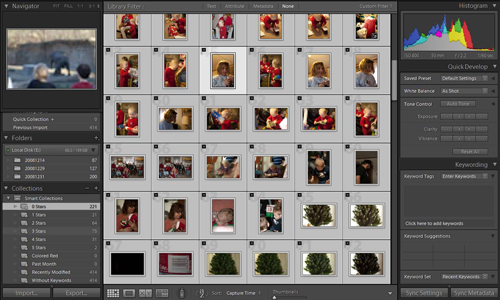
Now to delete the images we have selected and flagged, we need to go to the Catalog Palette in the left menu. Select All Photos.

Now from the menu bar select Photo >> Delete Rejected Photos… or use the shortcut {Ctrl/Cmd + Backspace}.
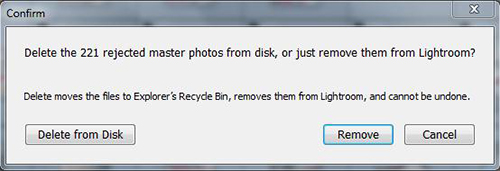
The Confirm dialog opens to warn you these images will be removed from the Lightroom Catalog and sent to the system Recycle Bin/Trash Can. If you are sure you really want to delete these flagged photos, click Delete from Disk. Go ahead, click, you know you really want to. Now you can empty the trash and free up that used disk space. Your garbage shots are forever gone.
Remember, just because you shot it does not mean you have to keep it.
Next, create a Smart Collection for 1 star images. Since these are the worst of your keepers, you might want to export them to jpeg and then remove the raw files from your disk. This keeps the images of limited value for viewing, but frees up resources wasted by keeping the raw file for an image with limited value.
Then you can create your 3 star collection. These are the sub-par images that you seem some redeemable value in. 3 star images can be kept as raw files in my opinion, as they should be workable images that can be cropped down or otherwise utilized. Just check the collection to make sure there are no images that you would rather export and delete. These are images you may want to keep in the catalog, as their value may be beneficial to you in the future.
2 star images should be check gain as to quality. If you feel that there is some redeeming value, bump the rating up to 3 stars and keep the raw file. Next, check again for any images that should have been rated 1 star. If so, select them and export to jpeg and delete the raw files. Then select all the images in the collection and delete.
This time choose to remove from catalog, then your raw files will still be available, but the images will no longer distract you in Lightroom. You might also consider exporting these images to jpeg before removal from your catalog.
After the rating and deletion of images is complete, you can then keep your current ratings, which I do, or select all the images in the collection and reset the rating to zero. If you like to really spread out your ratings, this may be a better option, but I only really work on 4 and 5 star images myself, so the ratings I gave initially should be good for any future editing.
Be vicious when critiquing your images and deleting. The harder you are on your images, the more you will find yourself improving. When you look at your catalogs, you will no longer be distracted by poor images, allowing you to focus only on images of good technical quality or importance.
Remember, just because you shot it does not mean you have to keep it. Only keep your best, because anything less should not consume your time.


